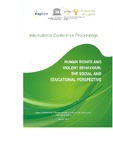| dc.description.abstract | The present work researches the types as well as the frequency of conflicts occurring
in a school unit of Secondary Education. Furthermore, it eχamines the ways chosen by
the school Headmasters to regulate the various types of conflicts presented in their
school.
The types of conflicts eχamined are divided into interpersonal conflicts, conflicts
between teams and conflicts between individuals and teams (Athanasoula-Reppa, 2008;
Bondesio, 1992; Zablanos, 1987; Hanson, 1996; Plocharczyk, 2007; Owens, 2001; Saitis,
1994).
Regarding the methods of conflict settlement some techniques were investigated;
avoidance - technique of ignoring, smoothing over - technique of separation,
compromise - technique of compromise, competition - use of authority and the
technique of problems resolution - technique of creating higher objectives
(Athanasoula- Reppa, 2008; Everard & Morris, 1999; Hakvoort, 201 Ο; Hanson, 1996;
Kantas, 2009).
In order to complete the survey a statistical review was carried out concerning the
subjects' responses in accordance with their seχ, age, years of service in public
education, additional studies, eχperience ίΓ1 a managerial position at school, training in
management and in managing conflicts and finally the type of school they direct.
The survey was conducted in May 201 Ο in Western Attica and attended by all the
Headmasters of Secondary schools, namely High School, Lyceum, Vocational Lyceum
(ΕΡΑL) and Technical School (EPAS) in the region. The type of the survey was a review,
the methodological tool was a questionnaire and the results were processed with the
program SPSS 17.0.
The results showed that three types of conflicts are very often perceived as factors of
conflict while two methods are very often selected to settle conflicts. | en_UK |


